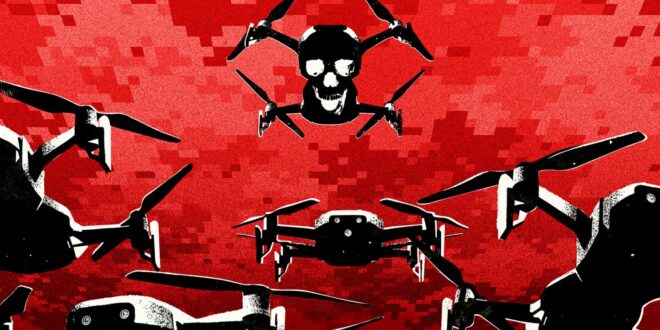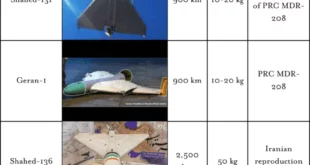Technology Is Remaking War—and America Must Adapt
At the beginning of the war in Ukraine in 2022, Ukrainian forces deployed a handful of Turkish-made Bayraktar TB2 uncrewed aerial vehicles to hit Russian targets. Those precise drone strikes were a sign of things to come. More than two years into the war, the TB2 is still a fixture of Ukraine’s arsenal, but it has been joined by a plethora of other uncrewed systems. Similar technology features in the current conflicts in the Middle East. Iran, Hezbollah in Lebanon, and the Houthis in Yemen launch one-way attack systems (drones armed with explosives that slam into their targets) and missiles at Israel, commercial shipping, and the U.S. Navy. For its part, Israel is using a range of unmanned vehicles in its war in Gaza. China is exploring ways to use uncrewed systems to blockade Taiwan and prevent outside powers from helping the island in the event of a Chinese attack. And the United States has launched several initiatives to help it rapidly field affordable uncrewed systems at greater scale. In all these cases, advances in artificial intelligence and autonomous systems, combined with a new generation of commercially available technologies and reduced manufacturing costs, are allowing militaries and militant groups to bring “mass” back to the battlefield.
For millennia, commanders considered mass—that is, having numerically superior forces and more materiel than the other side—critical to victory in battle. An army stood a greater chance of vanquishing its foes if it could deploy a greater number of troops, whether armed with spears, bows, and rifles or sitting in tanks. This principle dictated how militaries, especially those of great powers, pursued and achieved victory, from Roman legions in Gaul to the Soviet army on the eastern front of World War II. Having the biggest navy allowed the British empire to rule the seas, and having more planes empowered the Allies to bomb the Axis powers to smithereens. Mass has never been everything—better prepared, smaller militaries can thwart bigger and ostensibly more powerful ones—but it has traditionally established the odds in wars.
The last 50 years, however, saw a turn away from mass toward precision, a trend accelerated by the end of the Cold War. Militaries such as that of the United States discovered greater efficiency and effectiveness in the use of expensive advanced weapons that could accurately strike targets all over the world. Leaders chose to scale down the size of their forces and focus instead on honing their technological advantages.
Today’s wars and the assiduous investments made by the United States and China show that mass is making a comeback, but not at the expense of precision. Indeed, the current age of warfare is collapsing the binary between mass and precision, scale and sophistication. Call it the age of “precise mass.” Militaries find themselves in a new era in which more and more actors can muster uncrewed systems and missiles and gain access to inexpensive satellites and cutting-edge commercially available technology. With these tools, they can more easily conduct surveillance and stage accurate and devastating attacks. Its imperatives already shape warfare in Ukraine and the Middle East, influence dynamics in the Taiwan Strait, and inform planning and procurement in the Pentagon.
In the era of precise mass, war will be defined in large part by the deployment of huge numbers of uncrewed systems, whether fully autonomous and powered by artificial intelligence or remote-controlled, from outer space to under the sea. The U.S. military has positioned itself to lead in adapting to these changes in the character of warfare, but it must be ready to adopt innovations quickly and at scale. The pioneering breakthroughs evident in today’s conflicts merely foreshadow how wars will be waged in the years and decades to come as militaries grapple with the imperatives of both mass and precision.
THE QUEST FOR PRECISION
Countries long believed that they could achieve success on the battlefield by having more troops, equipment, and provisions than their opponents. The weight of numbers would deliver victory, the thinking went. But in the late 1960s, that theory started to change. The U.S. military began seeing virtue in precision over sheer quantity. U.S. forces sought to identify, track, and hit targets with ever-greater accuracy. That emphasis reduced the number of platforms and weapons necessary for military operations while also helping the United States comply with international humanitarian law by limiting the likely collateral damage of strikes.
In the 1970s, the United States and its European allies faced numerically superior Soviet forces. They could not match the Soviets tank for tank. Top U.S. military analysts feared that Moscow would win a war in Europe because of its quantitative advantage. To address these concerns, the United States introduced a program called Assault Breaker to integrate then-emerging technologies into military planning, with the intention of using precision missiles and bombs to devastate Soviet forces. Even if the Soviets achieved an initial breakthrough in an attack on central Europe, they would be unable to punch deep holes in Western lines. With sensors, early forms of guidance systems, and long-range weapons, the United States built the capability to destroy the second, third, and succeeding waves of Soviet forces in Europe.
The Cold War never turned hot in Europe, but precision strike capabilities would make their public debut in the first Gulf War in 1991. People around the world tuned into footage of laser-guided bombs slamming into Iraqi tanks. The decline of great-power competition—with the world focused on smaller conflicts such as those in Bosnia and Kosovo, and then counterterrorism and counterinsurgency in Afghanistan and Iraq—placed an enormous premium on accuracy, as most military operations happened between smaller forces in populated areas.
Throughout the first part of the twenty-first century, the United States maintained a generational lead in precision strike capabilities. At a time when the Pentagon faced skyrocketing costs for ground vehicles, aircraft, submarines, ships, and weapons, that advantage convinced the U.S. military that it could triumph by slimming down and prioritizing efficiency and accuracy over sheer numbers. The United States consciously chose to reduce the scale of its military and rely on precision. The overall inventory of the air force and the fleet size of the navy are about a third of the size they were in 1965, but the striking power of each aircraft and each ship or submarine is much larger.
A FALSE BINARY
The wheel has turned once again. The United States no longer enjoys the vast lead in precision strike capabilities that it once did. The technology underlying those capacities—conventional munitions, sensors, and guidance systems—has become cheaper over time and accessible to many countries and militant groups beyond the United States. From Azerbaijan to North Korea, other forces can strike some targets with the precision, power, and range that were once the preserve of the U.S. military. They have benefited from advances made in the private sector in artificial intelligence and the widening availability of sensing and communications platforms, such as global positioning systems. With this proliferation of know-how, technology, and weaponry, warfare is changing. Crucially, advances in manufacturing and software have lowered the price of key equipment. A cheap commercial drone equipped with weapons, guided by another cheap drone packed with sensors, can hit specific faraway targets or conduct surveillance operations. And because they are relatively inexpensive, such aircraft can be deployed at scale. Militaries are beginning to realize that they don’t have to choose between precision and mass; they can have both.
Systems of this kind are, in military parlance, “attritable”—that is, their relatively low cost makes the loss of any one system relatively insignificant. They are inferior in comparison with the most advanced weapons deployed by the U.S. or Chinese militaries—an F-35 stealth fighter, for example, or a Long-Range Anti-Ship Missile—but these systems can be deployed at a much greater scale than their more expensive counterparts. Their unit costs are low enough that their aggregate capabilities are more affordable.
To be sure, these cheap and precise systems are not making tanks, artillery, and other elements of modern warfare obsolete. They complement what came before, just as past innovations have; the advent of air warfare, for instance, did not spell the end of the use of infantry in battle. Future battlefields will be characterized by a mix of high-end systems deployed in smaller numbers, with these attritable systems deployed in far greater numbers.
These new trends and technologies have turned the war in Ukraine into a “battle lab,” as British Secretary of State for Defense Ben Wallace put it in 2023. Both sides have used flocks of relatively cheap drones to surveil and strike the other. In the sea, Ukraine’s robotic boats have delivered devastating blows to the Russian navy as part of a campaign that has damaged or destroyed a third of Russia’s Black Sea Fleet, according to Ukrainian estimates. Russia is now trying to eliminate these Ukrainian uncrewed vessels with remotely controlled drones guided by first-person-view piloting and targeting.
What’s different today, as opposed to in the first two decades of the twenty-first century, is the scale at which these capabilities are employed—their undeniable mass. Both Ukraine and Russia use, and sometimes lose, thousands of drones per week for tasks including surveillance and combat. Some of these drones are recoverable, whereas others are designed for one-way missions traveling hundreds of miles. Ukrainian President Volodymyr Zelensky announced in December 2023 that his country would produce over one million drones in 2024 and has created a separate branch of the military focused on uncrewed forces, informally known as Ukraine’s “army of drones.”
MASSIVE ATTACK
This shift in the character of war is occurring because of its potential advantages on the battlefield, not just because of its technical feasibility. Every actor, not just smaller states or nonstate actors, can generate immense striking power by deploying cheaper systems at great scale. For example, Ukraine can spend anywhere from a few hundred dollars for a tactical drone to help a small unit conduct surveillance to up to $30,000 for longer-range strike systems that can hit targets over 500 miles away. Russia employs a great number of Iranian-made Shahed-136 one-way attack systems, which have a range of roughly 1,500 miles and cost between $10,000 and $50,000. With weapons like these, it might take an army several shots to knock out a given target, but the aggregate cost for eliminating each target will be lower than it would be with more expensive weapons systems. For the sake of contrast, consider the sophisticated and very capable U.S. Joint Air-to-Surface Standoff Missile Extended Range. It will do the job, but public estimates place the cost of each missile at between $1 million and $2 million.
It is also much more expensive at present to defend against such attacks than it is to launch them. In April, Iran flung more than 300 weapons, including one-way attack drones, cruise missiles, and ballistic missiles, at Israel. With support from the United States and a handful of Middle Eastern countries, Israel repulsed almost all of the weapons. But at what cost? One report suggests the strike cost about $80 million to launch but $1 billion to defend against. A wealthy country and its allies could afford that sort of expense a few times—but maybe not 20 times, 30 times, or 100 times. Fending off this form of attack is not only expensive but also difficult. An assailant can strike at an adversary with a variety of systems; that adversary may be able to repel one specific system but struggle to deal with others. Commanders and analysts are only beginning to figure out how to counter precise mass at scale.
The United States no longer enjoys a vast lead in precision strike capabilities.
From the vantage point of the attacker, militaries can no longer assume that small numbers of high-end weapons will deliver victory. For example, some of Ukraine’s most advanced weapons, including U.S.-supplied High Mobility Artillery Rocket Systems and GPS-guided artillery shells, have faced challenges on the battlefield because Russia has developed the ability to jam their targeting and navigation systems. That is why Ukraine also needs the scale afforded by cheaper weapons systems to overwhelm Russian defenses.
The use of a great quantity of cheaper weapons systems can help make expensive, higher-end weapons more effective. A precise mass strike can exhaust an adversary’s air defenses, allowing more sophisticated but less numerous systems a better chance of hitting their targets. Russia, for instance, has mixed firing low-cost weapons with more expensive cruise missiles, including hypersonic missiles, against Ukraine.
The war that has now raged for more than two years in Ukraine shows that conflicts between states may remain nasty and brutish, but they are not always short. Countries stand a better chance of enduring such a protracted war with deep reserves of cheaper weapons systems, given that trying to maintain sufficient stocks of more expensive systems will be much more difficult. Focusing on precise mass allows militaries to prepare for the possibility that a war will not finish quickly and that years of combat lie ahead.
SHARPENING THE CUTTING EDGE
The Pentagon is often accused of being slow to innovate and adopt innovations, a struggle acknowledged by Deputy Secretary of Defense Kathleen Hicks. Several recent initiatives and programs, however, demonstrate growing Defense Department interest in precise mass and the adoption of these evolving technologies. The air force, for instance, is seeking to acquire lower-cost uncrewed combat aircraft that can fly alongside platforms such as F-35 fighters. It plans to procure these uncrewed aircraft by the end of the decade and deploy thousands of them. The secretary of the air force, Frank Kendall, even rode in an F-16 guided by artificial intelligence to highlight his branch’s embrace of new technologies. The air force is also working with the private sector to produce cruise missiles that could cost as little as $150,000 each, a fraction of the current cost of $1 million to $3 million. For its part, the navy has begun hiring specialists in robotic warfare, created a new squadron focused on uncrewed surface vessels, and experimented with large numbers of uncrewed platforms in the Middle East.
The most prominent U.S. military investment in precise mass is the Replicator initiative, which is focused on accelerating the adoption of innovations that the U.S. military needs now, not in five or ten years. The program’s first area of emphasis is in scaling “all-domain attritable autonomous” systems—the affordable platforms that define the new era of warfare—that can function everywhere from the air to underwater, with the goal of deploying many thousands of these systems by August 2025. The Pentagon has announced that the first Replicator investments include Switchblade 600, a one-way attack drone, along with uncrewed surface vessels and systems that can fend off aerial drones. Through Replicator, the Defense Department has made progress in developing capability in less than a year that would generally take multiple years to complete—leading Hicks to announce that the Defense Department is on track to achieve Replicator’s 2025 goals for attritable autonomous systems.
In addition to specific investments in precise mass, the U.S. military is making organizational adjustments to help the armed forces adapt to and adopt new technologies, refining how U.S. forces are organized, trained, equipped, and deployed. Marine units are experimenting with AI-enabled sensors that help soldiers understand the surrounding environment and monitor adversaries’ vessels. The army has created task forces working across multiple domains to test emerging capabilities in air, land, sea, space, and cyberspace and see how they can be effectively employed on the battlefield. The elevation of the Defense Innovation Unit—an organization within the Defense Department tasked with accelerating the development and deployment of commercially available technology—to report directly to the secretary of defense, and the dramatic budget increase it received from Congress in 2024, prove that both the Pentagon and Capitol Hill are taking these changes in warfare seriously.
Finally, the Rapid Defense Experimentation Reserve funds experimentation with capabilities that the U.S. military views as the most important for addressing challenges in the Indo-Pacific and other theaters. Already, three projects that came through the reserve’s initial set of activities are moving into the U.S. military, including the acceleration by five years of improvements to the Marine Corps’ ability to perform strike operations in the Indo-Pacific. Although there is more to be done, these advances demonstrate that the United States has laid the groundwork not only to take advantage of precise mass but also whatever comes next.
THE FOG OF THE FUTURE
The signs of major change in how wars are waged are unmistakable. The small, inexpensive drones deployed en masse in Ukraine over the last two years provide only a glimpse of what such wars could look like in the future. Militaries will have to figure out ways to defeat a precise mass strategy, and that effort will lead to further change. For instance, directed-energy weapons—arms that use highly focused energy, such as lasers or particle beams, instead of a solid projectile—could lower the cost per shot of defending against swarms of drones. American and British militaries have recently tested and deployed directed-energy systems designed to defend against aerial drones, including in the Middle East. To be sure, directed energy has been imagined as the technology of the future for at least four decades. But such weapons could indeed find a place in the wars to come.
What is certain is that standing still means falling behind. China, Russia, Iran and its proxies, and a range of other actors are not holding back in pursuing precise mass and its tangible benefits on the battlefield. Policymakers in Washington should be alarmed in particular by China’s rapid advances in everything from ships to hypersonic missiles to antiship missiles, combined with its enormous investments in artificial intelligence, interest in precise mass concepts, and ability to produce systems far more rapidly than the United States can today.
The U.S. military must stride forward faster; today’s innovations and prototypes must become tomorrow’s everyday military force if the United States is to preserve global leadership. The growing evidence of the effectiveness of precise mass systems should trigger not just conversations about future changes but also real changes in investments today—outlays that will influence a wide array of decisions, from the ships the navy builds to the missiles purchased by the army to the artificial intelligence infrastructure that every military service will need to use. Since the core underlying technologies driving these advances in precise mass come from the commercial sector, strategists will need to think through the consequences of the large-scale proliferation of such capabilities. The relative accessibility of precise mass systems will shape the way every country, not just the United States and China, prepares for the future.
 Eurasia Press & News
Eurasia Press & News



